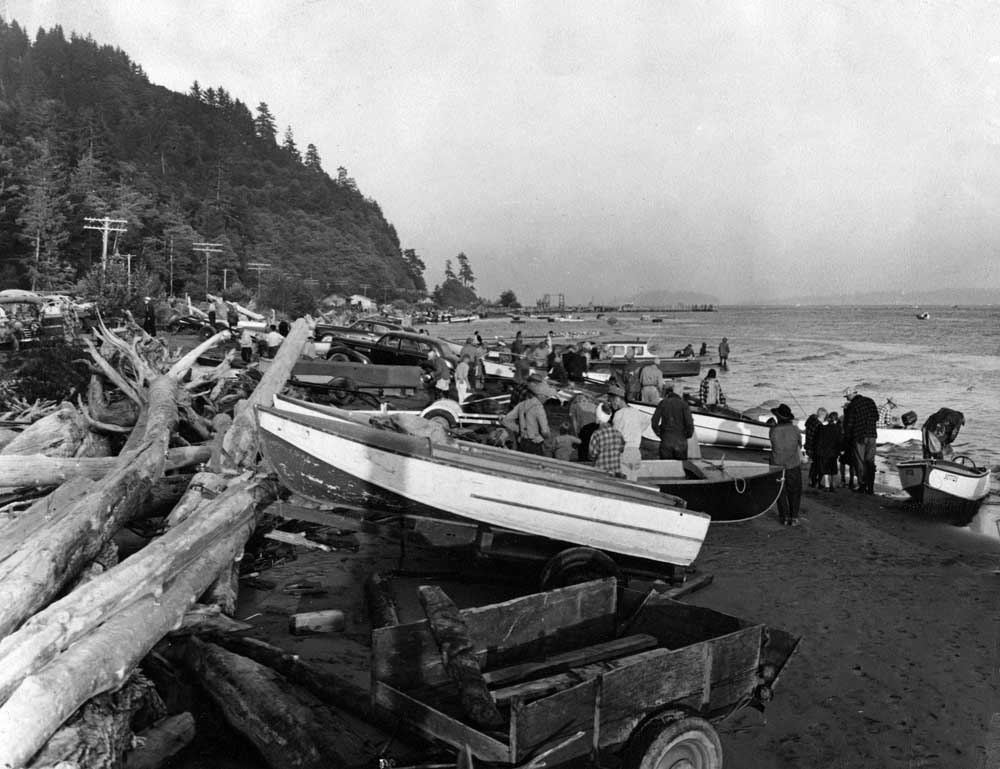Thrills & spills
Published 11:57 am Thursday, October 17, 2024

- During the middle years of the 20th century, many local fishing boats launched and returned to the Derbyville beach, just east of Chinook.
As the wind blew through the willows one day long ago, Ratty said to Mole, “Believe me, my young friend, there is nothing — absolutely nothing — half so much worth doing as simply messing about in boats.”
So true, but it can lead to trouble.
From a local newspaper of July 1926 comes an example:
“Andrew Esklola and his son … were the occupants of a gillnet boat which was run down by a steamer off 14th Street [in Astoria]. … Their boat was struck and carried along for a distance of approximately 200 feet by the Japanese steamer Iwatesan Maru, which was steaming up the river.
“According to fishermen who were nearby, Eskola had just finish laying out his net, partially in the channel. It was said that the steamer, after changing pilots off Ninth Street, suddenly veered off the regular channel, and bore down on Eskola’s boat. The fishermen attempted to cut loose their net and escape, but it was too late.
“The boat was swamped and somewhat damaged by the impact, but held closely to the sides of the steamer by the net which was entangled in the prow, the small craft was dragged along … before the net released it. Other fishermen nearby rushed to the aid of the two men.”
Small boats, big trouble
And from several undated issues of the Chinook Observer in the latter third of the 20th century, come the more typical sport fishing episodes:
• “… a 21-foot pleasure craft … hit a submerged object off the tip of the south jetty. The Coast Guard official said the craft sank in 1-1/2 minutes. … The submerged boat was towed to Cape Disappointment Coast Guard Station by a Coast Guard lifeboat.”
• “… a 25-foot pleasure craft … grounded … on a Willapa Bay mud flat. The craft’s anchor dragged during the night and placed the boat onto the mud flat after tides lowered. Two people were evacuated from the boat Thursday afternoon. As of last Sunday the craft remained on the mud flat.”
• “… within sight of the Cape Disappointment observation tower, three men were dumped into the water when the 17-foot pleasure craft they were riding in was capsized by a 10-foot breaker on Clatsop Spit. A Coast Guard spokesman said when the boat rolled over they called Air Astoria; within nine minutes a helicopter was on scene and picked up two men. … A 41-foot motor lifeboat picked up [the body of the third man.] He was dead on arrival at Ocean Beach Hospital in Ilwaco.”
• “… one body was recovered and another is missing after yet another boating accident on the Columbia Bar. The [wife’s] body … was recovered by a Coast Guard rescue crew inside Buoy 14, after the couple’s boat apparently capsized Saturday afternoon. The [husband’s] body … has not been located.”
The stories repeat, particularly during salmon season:
• “Astoria, Aug. 25, 1950 — (AP) — A Portland father and his 12-year-old son were rescued by the Coast Guard yesterday from their overturned outboard sports fishing boat. The boat was pinned in a fast-ebbing tide against a double row of piling on the Columbia River’s Chinook jetty spur. [A Coast Guard spokesman] said today he believed the two, battered and exhausted, would have drowned in another five minutes.” The Everett Daily Herald.
• Thirty-three years later — Oct. 25, 1983 — comes an echo: Two men were fishing in a 16-foot-skiff near Chinook Point when their boat capsized, throwing them into the [cold] water. One man survived by tying himself, for 12 hours, to the pilings near Fort Columbia State Park. The other man drowned; his body was found 24 hours later near a Columbia River jetty.
Elsewhere
The Columbia and its adjacent waters aren’t the only place where Northwest Coast sports fishermen get into trouble. In August of 1984 three anglers set out in their 17-foot pleasure boat, crossing the dangerous Tillamook Bar to fish in the ocean.
Their boat swamped during that crossing, throwing all three into the surf. The only survivor of the three was a visitor from Idaho who wore a full wet suit; the two residents of nearby Netarts, Ore., wore their life jackets but their dozen hours — or more — in the cold Pacific water overwhelmed the boost which their life preservers gave.
Unpredictable seas
Small boats can be at risk in the region’s unpredictable seas. Add to the sometimes-boisterous waters and an under-sized vessel the element of alcohol usage, and a fishing disaster is forecast. Early on a Saturday evening of Aug. 12, 1985, five people from Portland wedged themselves into a 19-foot craft to go fish the river’s mouth. The next morning their capsized fiberglass dinghy was reported by a bar pilot, and a 14-hour search was begun for the five. No one was found alive; one body was found in mid-September and another late in October.
One year later, in August 1986, the parents of one victim, a 14-year-old boy, filed a $2.5 million wrongful-death lawsuit against the estate of the boat’s operator, alleging “negligence and carelessness,” that he was visibly drunk and his boat was not seaworthy. The parents also filed suit against the City of Hammond for the harbormaster’s failure to stop the launching and departure, in view of the operator‘s, and his boat’s, condition.
The bar
And now, a word about the Columbia River Bar, as written by NOAA, the National Oceanic and Atmospheric Administration, and as relayed by Columbia River Kayaking’s website:
“The Columbia River Bar can be very dangerous because of sudden and unpredictable current changes accompanied by breakers.
“It is reported that ebb currents on the north side of the Bar attain speeds of 6 to 8 knots and that strong NW winds sometimes cause currents that set north in the area outside the jetties.
“In the entrance, the currents are variable and may reach a speed of over 5 knots on the ebb while the flood speed seldom exceeds 4 knots.
“The tidal current in the River is always modified by the river discharge, sometimes to the extent that the flood current is indiscernible and the current ebbs continuously.”
Heavy chop
Returning to our study, we see, yet again, that small boats and our local waters — which may blow up in just the merest flip of a fishing line — sometimes do not mix well:
Near Labor Day weekend in 1985, three people from Astoria went out on the river in a 14-foot aluminum boat. As they were heading home from fishing shortly after noon, the wind came to life, causing a heavy chop between Mott and Lois Islands upriver of Tongue Point. The chop flooded and overturned their small boat.
Two survived; one drowned — a week later his body was recovered near Desdemona Sands, west of the Astoria-Megler Bridge.
Heroes, fools
Once there was a hero at hand:
Late in October of 1985, two men set out in a 12-foot dory from the Hammond Mooring Basin into the face of an ebbing tide with a 2-foot wind chop. Their boat soon capsized and sank, consigning them to the chilly waters of the Far West’s greatest River.
The U.S. Army Corps of Engineers dredge Essayons happened to be at work nearby, from which a crewman dove into the water and rescued the two. The Coast Guard also dispatched a boat and a helicopter, but they weren’t needed.
And, in what seems like the ever-living end of folly, we have a 37-year-old man who left Kalama in an orange rubber raft. He intended to motor to Astoria 40 miles downriver. U.S. Coast Guard boats from Astoria and Portland, and a helicopter from Air Station Astoria, spent 14 hours looking for his body, to no avail.
(The Coast Guard can’t say this out loud, but I will: “People, please … use the good sense God gave us all!”)
Salmon fever
As readers might imagine, there is an unending litany of such stories where the wish to catch a beautiful salmon overwhelms the clear-eyed consideration of changes in weather, the size of the boat, and the abilities of the skipper.
So, when you’re out there having fun, messing about in a boat, remember what Mole might have said to Rat: “Put on your life jacket!”









